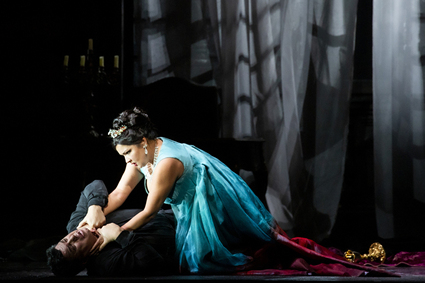| Opera Reviews | 6 May 2024 |
Anna Netrebko's temperamental Tosca opens La Scala's 2019/20 seasonby Silvia Luraghi |
|
| Puccini: Tosca Teatro alla Scala, Milan 13 December 2019 |
|

Luca Salsi (Scarpia), Anna Netrebko (Tosca)
|
|
|
As the 2019-20 season opener at La Scala musical director Riccardo Chailly chose Puccini’s Tosca, proposing, as he had already been done for Madama Butterfly in 2016, a critical version that included a few lines that Puccini had prepared for the world premiere of the opera in 1900 but later (or possibly already at the first performance) decided to leave out. Another major feature of opening night was the presence of both the outgoing and the incoming general managers: Alexander Pereira, now heading for Florence where he will manage the Maggio Musicale Fiorentino, and Dominique Mayer, who’s expected to leave the Wiener Staatsoper early in 2020. Opening night was telecast by public television in Italy and in several countries overseas, and, in spite of some small accidents partly due to the moving sets that caused some confusion in the performers, was very successful. I attended the third performance: by then the machine was perfectly oiled, and the singers more relaxed, so everything ran smoothly. The first thing that needs to be remarked is that Puccini knew very well what theatrical effects his music and the text of the librettos could achieve, and that he had left out some small parts because he had the feeling they should better be left out. And indeed he was right: the additions retrieved from the early score for this occasion can remain on the shelf where they have spent the last twelve decades. The production was directed by Davide Livermore, as the 2018 opening night of Attila had been. This time, the director in cooperation with set designer Giò Forma chose a traditional setting, and with the help of rotating parts of the stage, which could also be elevated to show the action taking place on two different levels, was able to create a wider space that could contain the side naves of the church of Sant’Andrea della Valle with the Attavanti chapel and the central altar in act one or the torture room below Scarpia’s office in act one. In act three, the execution took place on the background of a black wooden curtain that wraps the gate of the jail. Tosca jumps from the walls of Castel Sant’Angelo with a slow motion effect that was intended to mimic silent movies, but left many wondering about her final doom. The costumes designed by Gianluca Falaschi were not especially impressive (Tosca’s costumes in fact were rather ugly). In the title role, soprano Anna Netrebko, now at her third opening in five seasons, was a very temperamental Tosca. Her second act aria ‘Vissi d’arte’ literally brought down the house, but other moments were equally impressive, such as her duets with Cavaradossi in the first and third acts. At her side, tenor Francesco Meli lent his ringing voice to the unfortunate painter, and tackled his role with a secure and perfectly tuned top range that he showcased on the occasion of the numerous high notes required by the score. Baritone Luca Salsi was a compelling Scarpia, evil minded and sneaky at the right point. A real luxury cast was bass-baritone Alfonso Antoniozzi in the role of the sacristan. The orchestra was conducted with the usual care and skill by Riccardo Chailly, and the chorus of La Scala, instructed by Bruno Casoni was joined in the first act by the children’s chorus of the Academy. The house was packed, and among special guests one could notice Plácido Domingo, currently in Milan for his upcoming Gala Concert which will celebrate his 50th anniversary at La Scala.
|
|
| Text ©
Silvia Luraghi Photo © Brescia/Amisano – Teatro alla Scala |
|







